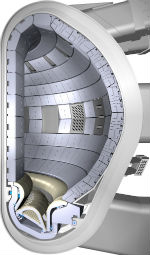
https://www.neimagazine.com/features/fe ... l-4551656/
ITER is based on the 'tokamak' concept of magnetic confinement, in which the plasma is contained in a doughnut-shaped vacuum vessel. The fuel - a mixture of deuterium and tritium, two isotopes of hydrogen - is heated to more than 150 million °C, to form a hot plasma. Strong magnetic fields are used to keep the plasma away from the walls; these are produced by superconducting coils surrounding the vessel, and by an electrical current through the plasma.
The blanket covers the interior surfaces of the vacuum vessel, shielding the vessel and the superconducting magnets from the heat and neutron flux of the fusion reaction. The neutrons are slowed down in the blanket where their kinetic energy is transformed into heat energy and collected by the coolant. In a fusion power plant, this energy will be used for electrical power production.
For ease of maintenance on the interior of the vacuum vessel, the blanket wall is modular. It has 440 segments, each measuring 1x1.5m and weighing up to 4.6t. Each segment has a detachable first wall, which directly faces the plasma and removes the plasma heat load, and a semi-permanent blanket shield for neutron shielding.





